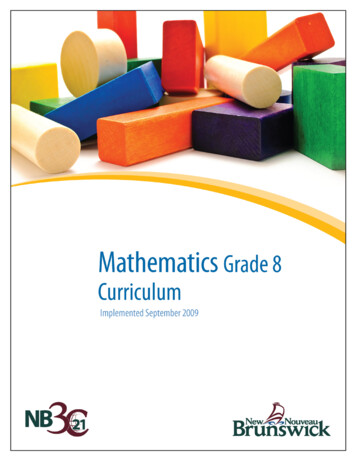
Transcription
contemporarybusinessmathematicswith canadianapplicationsA01 HUMM2312 FM.pi-001.indd 127/11/13 9:55 PM
A01 HUMM2312 FM.pi-001.indd 227/11/13 9:55 PM
S. A. Hummelbrunnerkelly hallidayK. suzanne coombscontemporarybusinessmathematicswith canadianapplications10theditionTorontoA01 HUMM2312 FM.pi-001.indd 327/11/13 9:55 PM
Acquisitions Editor: Megan FarrellMarketing Manager: Claire VarleyDevelopmental Editor: Johanna SchlaepferProgram Manager: Patricia CiardulloProject Manager: Jessica HellenProduction Services: Katie Ostler, Cenveo Publisher ServicesMedia Editor: Charlotte Morrison-ReedMedia Producer: Kelli CadetPermissions Project Manager: Joanne TangPhoto Permissions Research: Q2a/Bill Smith/Cordes HoffmanText Permissions Research: Jill Dougan, Electronic Publishing Services Inc.Cover and Interior Designer: Anthony LeungCover Image: Getty ImagesCredits and acknowledgments of material borrowed from other sources and reproduced, with permission, inthis textbook appear on the appropriate page within the text.If you purchased this book outside the United States or Canada, you should be aware that it has been importedwithout the approval of the publisher or author.Copyright 2015, 2012, 2009, 2008, 2001, 1998 Pearson Canada Inc. All rights reserved. Manufactured in theUnited States of America. Th s publication is protected by copyright and permission should be obtained fromthe publisher prior to any prohibited reproduction, storage in a retrieval system, or transmission in any formor by any means, electronic, mechanical, photocopying, recording, or likewise. To obtain permission(s) to usematerial from this work, please submit a written request to Pearson Canada Inc., Permissions Department, 26Prince Andrew Place, Don Mills, Ontario, M3C 2T8, or fax your request to 416-447-3126, or submit a requestto Permissions Requests at www.pearsoncanada.ca.10 9 8 7 6 5 4 3 2 1 [CKV]Library and Archives Canada Cataloguing in PublicationHummelbrunner, S. A. (Siegfried August), authorContemporary business mathematics with Canadianapplications/ S.A. Hummelbrunner, Kelly Halliday,K. Suzanne Coombs.—Tenth edition.Includes index.ISBN 978-0-13-305231-2 (bound)1. Business mathematics—Textbooks. I. Halliday, Kelly, authorII. Coombs, Suzanne, author III. Title.HF5691.H85 2014 650.01’513C2013-904776-XISBN 978-0-13-305231-2A01 HUMM2312 FM.pi-001.indd 427/11/13 9:55 PM
1.2fractionsvBrief ContentsPreface xiStudent’s Reference Guide to Rounding and Special Notations xxPart1Mathematics Fundamentals and Business Applications 2Part232 Review of Basic Algebra 383 Ratio, Proportion, and Percent 844 Linear Systems 133Mathematics of Business and Management 169Part1 Review of Arithmetic 45 Cost-Volume-Profit Analysis and Break-Even 1716 Trade Discounts, Cash Discounts, Markup, and Markdown 2017 Simple Interest 2468 Simple Interest Applications 277Mathematics of Finance and Investment 309910111213141516Compound Interest—Future Value and Present Value 312Compound Interest— Further Topics 363Ordinary Simple Annuities 391Ordinary General Annuities 432Annuities Due, Deferred Annuities, and Perpetuities 463Amortization of Loans, Including Residential Mortgages 517Bond Valuation and Sinking Funds 569Investment Decision Applications 613Appendix I: Further Review of Basic Algebra 648Appendix II: I nstructions and Tips for Three Preprogrammed FinanciaCalculator Models 668Answers to Odd-Numbered Problems, Review Exercises,and Self-Tests 685Index 699A01 HUMM2312 FM.pi-001.indd 527/11/13 9:55 PM
ContentsPreface xiStudent’s Reference Guide to Rounding and Special Notations xxPart1Mathematics Fundamentals and Business Applications 21 Review of Arithmetic 41.1 Basics of Arithmetic 51.2 Fractions 61.3 Applications—Averages 121.4 Applications—Payroll 181.5 Applications—Taxes 25Business Math New s Box 29Review Exercise 31Self-Test 33Challenge Problems 34Case Study Businesses and the Gst/Hst 34Glossary 362 Review of Basic Algebra 382.1 Simplification of Algebraic Expressions 392.2 Integral Exponents 452.3 Fractional Exponents 522.4 Logarithms—Basic Aspects 56Business Math New s Box 622.5 Solving Basic Equations 632.6 Solving Equations Involving Algebraic Simplification 672.7 Solving W ord Problems 72Review Exercise 77Self-Test 78Challenge Problems 80Case Study Investing in a Tax-Free Savings Account 80Summary of Formulas 81Glossary 823 Ratio, Proportion, and Percent 843.1 Ratios 853.2 Proportions 903.3 Percent 953.4 The Basic Percentage Problem 993.5 Problems Involving Increase or Decrease 1063.6 Problems Involving Percent 111Business Math New s Box 1153.7 Applications—Currency Conversions 1173.8 Applications—Index Numbers 121A01 HUMM2312 FM.pi-001.indd 627/11/13 9:56 PM
CONT E NTS3.9viiApplications—Personal Income Taxes 124Review Exercise 127Self-Test 129Challenge Problems 130Case Study The Business of Taxes 131Summary of Formulas 132Glossary 1324 Linear Systems 1334.1 Algebraic Solution of Systems of Linear Equations in Two Variables 1344.2 Graphing Linear Equations 1394.3 Graphing Linear Systems of Equations in Two Unknowns 152Business Math New s Box 1554.4 Problem Solving 156Review Exercise 161Self-Test 162Challenge Problems 162Case Study Finding the Right Combination 163Summary of Formulas 163Glossary 164Part 1 Comprehensive Case 165Part2Mathematics of Business and Management 1695 Cost-Volume-Profit Analysis and Break-Even 1715.1 Cost-Volume-Profit Analysis and Break-Even Charts 1725.2 Contribution Margin and Contribution Rate 1875.3 Effects of Changes to Cost-Volume-Profit 191Business Math New s Box 194Review Exercise 196Self-Test 197Challenge Problems 198Case Study Segway Tours 198Summary of Formulas 199Glossary 2006 Trade Discounts, Cash Discounts, Markup, and Markdown 2016.1 Determining Cost with Trade Discounts 2036.2 Payment Terms and Cash Discounts 2116.3 Markup 2196.4 Markdown 2276.5 Integrated Problems 232Business Math New s Box 239A01 HUMM2312 FM.pi-001.indd 7Review Exercise 240Self-Test 242Challenge Problems 243Case Study Focusing on Prices 243Summary of Formulas 244Glossary 24527/11/13 9:56 PM
viiicontents7 Simple Interest 2467.1 Finding the Amount of Simple Interest 2477.2 Finding the Principal, Rate, or Time 2517.3 Computing Future Value (Maturity Value) 2567.4 Finding the Principal (Present Value) 258Business Math New s Box 2617.5 Computing Equivalent Values 261Review Exercise 273Self-Test 274Challenge Problems 274Case Study Cost of Financing Pay Now or Pay Later 275Summary of Formulas 276Glossary 2768 Simple Interest Applications 2778.1 Promissory Notes 2788.2 Treasury Bills—Present Value 2858.3 Demand Loans 2878.4 Lines of Credit and Credit Card Loans 2918.5 Loan Repayment Schedules 296Business Math New s Box 300Review Exercise 301Self-Test 302Challenge Problems 303Case Study Debt Consolidation 303Summary of Formulas 304Glossary 305Part 2 Comprehensive Case 306Part3Mathematics of Finance and Investment 3099 Compound Interest—Future Value and Present Value 3129.1 Basic Concepts and Calculations 3139.2 Using the Future Value Formula of a Compound AmountFV PV (1 i)n 3199.3 Present Value and Compound Discount 3319.4 Application—Discounting Negotiable Financial Instrumentsat Compound Interest 336Business Math New s Box 3429.5 Equivalent Values 343Review Exercise 358Self-Test 359Challenge Problems 360Case Study Planning Ahead 361Summary of Formulas 362Glossary 36210 Compound Interest—Further Topics 36310.1 Finding n and Related Problems 36410.2 Finding i and Related Problems 372A01 HUMM2312 FM.pi-001.indd 827/11/13 9:56 PM
CONT E NTSix10.3 Effective and Equivalent Interest Rates 377Business Math New s Box 385Review Exercise 387Self-Test 388Challenge Problems 388Case Study Comparing Car Loans 389Summary of Formulas 389Glossary 39011 Ordinary Simple Annuities 39111.1 Introduction to Annuities 39211.2 Ordinary Simple Annuity—Finding Future Value FV 39411.3 Ordinary Simple Annuity—Finding Present Value PV 404Business Math New s Box 41311.4 Ordinary Simple Annuities—Finding the Periodic Payment Pmt 41411.5 Finding the Term n of an Annuity 42011.6 Finding the Periodic Rate of Interest i Using Preprogrammed FinancialCalculators 425Review Exercise 427Self-Test 428Challenge Problem 428Case Study Getting the Picture 429Summary of Formulas 430Glossary 43012 Ordinary General Annuities 43212.1 Ordinary General Annuities—Finding the Future Value FV 43312.2 Ordinary General Annuities—Finding the Present Value PV 44112.3 Ordinary General Annuities—Finding the Periodic Payment Pmt 44412.4 Ordinary General Annuities—Finding the Term n 44712.5 Ordinary General Annuities—Finding the Periodic Interest Rate i 450Business Math New s Box 45112.6 Constant-Growth Annuities 453Review Exercise 458Self-Test 459Challenge Problem 460Case Study Vehicle Cash-Back Incentives 460Summary of Formulas 461Glossary 46213 Annuities Due, Deferred Annuities, and Perpetuities 46313.1 Simple Annuities Due 46413.2 General Annuities Due 477Business Math New s Box 48413.3 Ordinary Deferred Annuities 48513.4 Deferred Annuities Due 49413.5 Perpetuities 502A01 HUMM2312 FM.pi-001.indd 9Review Exercise 510Self-Test 512Challenge Problems 51327/11/13 9:56 PM
xContentsCase Study Planning for University 514Summary of Formulas 515Glossary 51614 Amortization of Loans, Including Residential Mortgages 51714.1 Amortization Involving Simple Annuities 51814.2 Amortization Involving General Annuities 53814.3 Finding the Size of the Final Payment 54414.4 Residential Mortgages in Canada 552Business Math New s Box 559Review Exercise 564Self-Test 566Challenge Problems 567Case Study Managing a Mortgage 567Summary of Formulas 568Glossary 56815 Bond Valuation and Sinking Funds 56915.1 Purchase Price of Bonds 57015.2 Purchase Price of a Bond W hen Market Rate Does not Equal Bond Rate 571Business Math New s Box 58415.3 Bond Schedules 58515.4 Finding the Yield Rate 59015.5 Sinking Funds 593Review Exercise 607Self-Test 609Challenge Problems 610Case Study Raising Capital Th ough Bonds 610Summary of Formulas 611Glossary 61216 Investment Decision Applications 61316.1 Discounted Cash Flow 61416.2 Net Present Value 621Business Math New s Box 63116.3 Rate of Return on Investment 632Review Exercise 644Self-Test 645Challenge Problems 646Case Study To Lease or Not to Lease? 646Summary of Formulas 647Glossary 647Part 3 Comprehensive Case 649Appendix I:Appendix II:Further Review of Basic Algebra 652Instructions and Tips for Three Preprogrammed Financial Calculator Models 672Answers to Odd-Numbered Problems, Review Exercises, and Self-Tests 685Index 699A01 HUMM2312 FM.pi-001.indd 1027/11/13 9:56 PM
PrefaceIntroductionContemporary Business Mathematics with Canadian Applications is intended for usein introductory mathematics of finance courses in post-secondary business management, marketing, accounting, and fi ance programs. It also provides a review of basicmathematics.The primary objective of the text is to increase the student’s knowledge and skill inthe solution of practical fi ancial and operational problems encountered in operatinga business.Organization318ChAPTEr 9COMPOUND INTErEST—fUTUrE vALUE AND PrESENT vALUEContemporary Business Mathematics with Canadian Applications is a teaching textusing problem-identifi ation and problem-solving approaches. The systematic andsequential development of the material is illustrated by examples that show a step-bystep approach to solving the problem. The detailed solutions are presented in a visuallyclear and colourful layout that allows learners to monitor their own progress in theclassroom or in independent study.Each topic in each chapter is followed by F. Calculating the numerical value of the compounding factor (1 1 i )practice exercises containing numerous drillquestions and application problems. At the endof each chapter, Review Exercises, Self-Test, and aCase Study integrate the material presented.The fi st four chapters and Appendix I (FurtherReview of Basic Algebra) are intended for studentswith little or no background in algebra and providean opportunity to review arithmetic and algebraicprocesses.The text is based on Canadian practice, and reflects current trends using available technology—specifi ally the availability of preprogrammed fi ancial calculators.Students using this book should have access to calculators having a power functionand a natural logarithm function. The use of such calculators eliminates the constraintsassociated with manually calculating results using formulas.In solving problems involving multiple steps, often values are determined that willbe used in further computations. Such values should not be rounded and all availabledigits should be retained in the calculator. Using the memory functions of the calculator enables the student to retain such non-rounded values.W hen using the memory the student needs to be aware that the number of digitsretained in the registers of the calculator is greater than the number of digits displayed.Depending on whether the memory or the displayed digits are used, slight differencesmay occur.Students are encouraged to use preprogrammed fi ancial calculators. The use ofthese preprogrammed calculators facilitates the solving of most fi ancial problems andis demonstrated extensively in Chapters 9 to 16.(iii)(iv)(v)(vi)(vii)12% p.a. compounded quarterly for 12.5 years;10.5% p.a. compounded monthly for 10.75 years;8% p.a. compounded quarterly for 30 months;9.5% p.a. compounded semi-annually for 42 months;5.8% p.a. compounded daily for 2 years.SOLUTION(1 1 i ) nmn(i)5% 5 0.05114(1) 5 14(1 1 0.05)14 5 1.0514(ii)7% 4 2 5 0.035215(2) 5 30(1 1 0.035)30 5 1.03530i412.5(4) 5 50(1 1 0.03)50 5 1.035010.5% 4 12 5 0.008751210.75(12) 5 129(1 1 0.00875)129 5 1.00875129(v)8% 4 4 5 0.02430/12(4) 5 10(1 1 0.02)10 5 1.0210(vi)9.5% 4 2 5 0.0475242/12(2) 5 7(1 1 0.0475)7 5 1.04757(vii)5.8% 4 365 5 0.000159*(iii)12% 4 4 5 0.03(iv)365(1 1 0.058/365)730 5 (1.000159*)7302(365) 5 730*roundednThe numerical value of the compounding factor, (1 1 i)n, can now be computed usingan electronic calculator. For calculators equipped with the exponential function featurey x , the numerical value of the compounding factor can be computed directly.STEP 1Enter the numerical value of (1 1 i) in the keyboard.STEP 2Press the exponential function key y xSTEP 3Enter the numerical value of n in the keyboard.STEP 4Press 5STEP 5Read the answer in the display. Continue calculating or save as needed.The numerical values of the compounding factors in Example 9.1C are obtained asfollows:(i)(ii)STEP 1Enter1 1 0.05STEP 2PressyxSTEP 3Enter14STEP 4Press5STEP 5read1.9799322.806794(iii)(iv)1 1 0.07/2 1 1 0.12/4 1 1 0.105/12yx(v)(vi)(vii)1 1 0.08/41 1 0.095/21 1 95554.3839063.0766471.218994Note: Do not be concerned if your calculator shows a difference in the last decimal.There is no error. It reflects the precision of the calculator and the number of decimalplaces formatted to show on the display of the calculator.For example, if your calculator has been set to show only two decimal places, it willautomatically round the answer to (i) above to 1.98. If you were to continue calculatingM09 HUMM2312 CH09.p309-362.indd 318A01 HUMM2312 FM.pi-001.indd 1105/09/13 12:06 PM27/11/13 9:56 PM
xiip r e fa c eNew To This EditionThe Tenth Edition of Hummelbrunner/Halliday/Coombs, Contemporary BusinessMathematics with Canadian Applications, includes updates based on changes in current practices in Canadian fi ance and business and the needs of students and instructors using this book. Th s edition continues to clarify the consistent approach to rounding rules. TheStudent’s Reference Guide to Rounding and Special Notation (pages xx–xxiii)gives a clear explanation of the rounding conventions used throughout the text.Additional Pointers and Pitfalls boxes are placed in key areas to remind studentsabout the rounding conventions and exceptions in practice. The text and solutions manual have been thoroughly technically checked for accuracy and consistency with the rounding approach. Tables, charts, and further diagrams have been added to enable the learner to visualize the problems and the solutions. Numerous new examples and exercises have been added. Chapter 5 has been signifi antly revised with emphasis on the relationships betweenparts of CVP. Break-even charts are integrated with theory by introducing them afterexplanations of revenue and cost behaviour. Chapter 6 has been signifi antly revised with standardized formulas and wording,illustrated by visual approaches to solving the problems. Canadian references have been emphasized in Business Math News Boxes and websitereferences. Interest rates refl ct current investment and borrowing rates.Many examples and exercises have been updated, rewritten, and expanded. To enhancethe building-block approach, exercises are ordered to link the topics and the solvedexamples. Help references have been expanded to link selected exercises to solvedexamples.Specifi ally, in Chapter 1 (Review of Arithmetic), prices, salaries, and wages havebeen updated. Revised rates and calculations for GST/PST/HST have been included toincorporate new legislation for 2012 and property tax terminology and valuations havebeen updated.In Chapter 2 (Review of Algebra), the chapter-opening vignette emphasizes whybusiness students need algebra, and new exercises have been added to utilize formulasfor simple and compound interest. Calculator solutions have been introduced for several examples and formulas have been simplifi d.In Chapter 3 (Ratio, Proportion, and Percent), a consistent approach for calculating proportions has been introduced, and formulas throughout the chapter have beenupdated for consistency. Drill questions have been replaced by more word problems,and alternative solutions have been included. Currency conversion rates, prices, CPInumbers, and personal income taxes have been updated.In Chapter 4 (Linear Systems), the comparison/substitution method for solvingthe point of intersection of two linear systems has been emphasized. A new BusinessMath News Box ties more closely to the chapter-opening vignette and introduces amanufacturing capacity example.The order of Chapter 5 and Chapter 6 has been switched in the Tenth Edition toimprove the fl w of content from Linear Systems (Chapter 4) to Cost-Volume-ProfitAnalysis and Break-Even (Chapter 5). Th s chapter has been changed signifi antly,beginning with an updated title to refl ct break-even as an application of the profitfunction, not the focus of the chapter. The opening vignette now includes an example that connects with the Business Math News Box presented later in the chapter. TheA01 HUMM2312 FM.pi-001.indd 1202/12/13 8:03 PM
p r e fa c exiiinumber of formulas has been reduced, and solutions to examples use a simplifi dapproach for calculating break-even.Chapter 6 (Trade Discounts, Cash Discounts, Markup, and Markdown) haschanged signifi antly. For consistency and clarity, terminology and explanationshave been simplifi d and formulas have been standardized. New Pointers andPitfalls boxes provide tools to help students rearrange formulas, determine thenumber of days in a discount period, and calculate markup. A sample invoicedemonstrates payment terms and cash discounts. EOG and ROG examples thatappeared in the Eighth Edition of the text have been added back in this edition.In Chapter 7 (Simple Interest), the chapter-opening vignette ties in with thechapter’s Business Math News Box. Dates and interest rates have been updated andnew exercises have been added, with exercises referenced to examples. Additionalcomments for choosing focal dates have been added, with a section included showing an example of the use of Excel functions.In Chapter 8 (Simple Interest Applications), the use of grace periodshas been updated, with exercises omitting its use. Comments on credit ratings,credit scores, home equity lines of credit, and new exercises using credit cards havebeen added. Treasury bill interest rates have been updated to refl ct current rates.A new Business Math News Box addresses the question, “How do you learn aboutmoney?”In Chapter 9 (Compound Interest—Future Value and Present Value), visualexplanations have been expanded. The introduction to Future Value, and explanation of the periodic rate of interest, have been simplifi d. The relationship betweenn and m has been clarifi d, with a new formula added to explain the calculation ofn. The calculation of a partial year to a rounded number has been eliminated, keeping the year as a fraction. A new section showing Excel’s FV and PV calculationsis included, with visual examples. New figures have been added. The number ofreview and self-test exercises has been reduced to eliminate duplication. Formulashave been simplifi d with the elimination of references to S and P.In Chapter 10 (Compound Interest—Further Topics), formula variations havebeen identifi d, explained, and illustrated. A Pointers and Pitfalls box has beenadded to address formula rearrangement. Several examples have been rearrangedto show the simpler examples fi st. New sections have been added to illustrate theuse of Excel functions. New exercises and new charts are included. The issue ofdebt repayment is addressed in a new Business Math News Box.In Chapter 11 (Ordinary Simple Annuities) and in Chapter 12 (OrdinaryGeneral Annuities), new business application exercises and examples with diagrams have been included. New Pointers and Pitfalls boxes have been added toremind students about clearing calculator inputs, using inversion techniques whencalculating, understanding the term “payment,” and the calculator’s positive/negative sign convention. The explanation regarding the purpose of method for presentvalue calculations has been expanded. A new Business Math News Box refers to apopular and successful Canadian entrepreneur.In Chapter 13 (Annuities Due, Deferred Annuities, and Perpetuities), explanations, diagrams, and calculations for annuities due are simplifi d. The order ofsome examples has been changed to provide a more logical and intuitive learningsequence. New examples with diagrams have been added, including reference toinvestments in preferred shares. A new Pointers and Pitfalls box reminds the readerhow to calculate periodic interest rates on the calculator.In Chapter 14 (Amortization of Loans, Including Residential Mortgages), anew section with a diagram develops the skills to fi d the interest, principal, andA01 HUMM2312 FM.pi-001.indd 1327/11/13 9:56 PM
xivp r e fa c ebalance for a period, and bridges between fi ding the payment and constructing theamortization schedule. The introduction to residential mortgages has been updated torefl ct current legislation on mortgage insurance. Examples and exercises have beenreordered and clarifi d to enhance building-block learning.In Chapter 15 (Bond Valuation and Sinking Funds), explanation of basic conceptshas been expanded to answer the “why?” questions. The order has been changed, with afocus on calculation of bond price under different conditions. An introductory sectionhas been added for concept comprehension. Calculating the purchase price of a bondhas been separated into two sections based on whether or not the market rate equals ordoes not equal the bond rate. A new Business Math News Box describes and discussesCanada Savings Bonds.In Chapter 16 (Investment Decision Applications), explanations begin the section on Net Present Value, followed by introductory, then more advanced, applications.Repetitive calculator instructions have been eliminated. Computing the Rate of Returnby manual methods has been condensed and new visuals have been added.Comprehensive Case StudiesComprehensive case studies for each part of the book have been created. The questions within each case study have been separated by chapter or group of chapters tofacilitate the use of these case studies by those institutions that include only some of thetopics in their course syllabus. W ith the questions separated and identifi d by chapter,these institutions can use part of the case study in their courses.Part 1 Mathematics Fundamentals and Business ApplicationsTil Debt Do Us Part host Gail Vaz-Oxlade has made it her mission to help couples whoare headed for disaster get out of debt. Questions for each of Chapters 1–4 are included.Part 2 Mathematics of Business and ManagementA sporting equipment manufacturer and retailer, SportZ Ltd., is based in Alberta.Questions for each of Chapters 5–8 are included.Part 3 Mathematics of Finance and InvestmentBased in Ontario, Lux Resources Group, Inc., rents and sells construction equipment.Questions for each of Chapters 9–16 are included.In general, interest rates used refl ct the current economic climate in Canada.Calculator tips and solutions have been updated or clarifi d. Spreadsheet instructionsand Internet website references have been updated. Pitfalls and Pointers have beenincluded to assist in performing tasks and interpreting word problems, and sectionshave been rewritten to clarify the explanations. Many more word problems have beenadded and references to solved examples have been added. Business Math News Boxesand Case Studies have been updated. Examples involving both business and personalsituations are included. The pedagogical elements of the previous edition have beenretained. In response to requests and suggestions by users of the book, a number ofnew features for this edition have been included. They are described below.FeaturesUpdated! A new colourful and student-friendly design has been created for the book, makingit more accessible and less intimidating to learners at all levels.322CHAPTER 9COMPOUND INTEREST—FUTURE VALUE AND PRESENT VALUEtable 9.3 Financial Calculator Function Keys That Correspond to Variables Used in Compound Interest CalculationsUpdated! Any preprogrammed fi ancial calculator may beused, but this edition includes extensive instructions for using the Texas Instruments BA II PLUSfinancial calculator. Equivalent instructionsFunction KeyalgebraicSymbolVariableThe number of compounding periods1tiBa ii pluSSharpEl-738CNnnHp10bii1Ni1/YRThe periodic annuity payment2PMTPMTPMTPMTThe present value or principalPVPVPVPVThe future value or maturity valueFVFVFVFVThe rate of interestNotes:iI/YC/Y1. The periodic rate of interest, (i ) is entered as a percent and not as a decimal equivalent (as it is whenusing the algebraic method to solve compound interest problems). For example, 8% is entered as “8”not “.08.” With some calculators, the rate of interest is the periodic rate. In the case of the BA IIPlus, the rate of interest entered is the nominal rate per year I/Y .2. The periodic annuity payment function key PMT is used only for annuity calculations, which areintroduced in Chapter 11.Using the Texas Instruments BA II PlUs to solve Compound Interest ProblemsFollow the steps below to compute the future value of a sum of money using the formula FV PV(1 i)n and a Texas Instruments BA II Plu S calculator. Compare yourresult with that in Example 9.2A.pre-calculation phase (initial Setup)sTEP 1A01 HUMM2312 FM.pi-001.indd 14The P/Y register, and behind it, the C/Y register, must be set to match the calculator’sperformance to the text presentation. The P/Y register is used to represent the numberof regular payments per year. If the text of the question does not discuss regular payments per year, this should be set to equal the C/Y in the calculator. The C/Y registeris used to represent the number of compounding periods per year; that is, the com-27/11/13 9:56 PM
xvp r e fa c eare given in Appendix II for the Sharp EL-738Cand the Hewlett-Packard 10bII financialcalculators.new! Each part opens with an introduction to theupcoming chapters and a discussion of therounding conventions that are relevant to thesechapters.10.1ChapTer The Pointers and Pitfalls boxes emphasizegood practices, highlight ways to avoid common errors, show how to use a fi ancial calculator effici tly, or give hints for tackling businessmath situations to reduce math anxiety.Upon completing this chapter, you will be able to do the following:❶ determine the number of conversion periods and find equateddates.❷ Compute periodic and nominal rates of interest.❸ Compute effective and equivalent rates of interest.»Discount 5 5% of 560 5 0.05 3 560 5 28.bUsiness math news bOxnational salary ComparisonsKnowing how much you are worth in the job market is critical for not being underpaid. Successful salary negotiations are accomplished by having accurate information. In today’s electronic age, the Internet offers a variety of websites focusing on05/09/13salary information.Th ee popular job functions along with the respective salaries are listed belowby major metropolitan location.M10 HUMM2312 CH10.p363-390.indd 363Financial ControllerResponsible for directing an organization’s accounting functions. These functions include establishing andmaintaining the organization’s accounting principles, practices, and procedures. Prepares financial reportsand presents fi dings and recommendations to top management.Human Resources ManagerPlans, directs, and coordinates the human resource management activities of an organization to maximizethe strategic use of human resources and maintain functions such as employee compensation, recruitment,personnel policies, and regulatory compliance
Contemporary Business Mathematics with Canadian Applications is intended for use in introductory mathematics of finance courses in post-secondary business manage-ment, marketing, accounting, and fi ance programs. It also provides a review of basic mathematics. The primary objective of the










